Westfield Garden City: Australian Shopping Mall Success Factors
VerifiedAdded on 2021/06/17
|15
|3859
|84
Report
AI Summary
This report investigates the factors contributing to the success of shopping malls in Australia, with a specific focus on Westfield Garden City. The study delves into various elements, including strategic location, tenant mix, ample parking, effective marketing, and the incorporation of entertainment and customer experience. The literature review examines the reasons behind the success of Australian malls compared to struggling malls in other countries, such as the United States. The research design employs a case study approach, utilizing both primary data gathered through interviews with tenants and customers, and secondary data such as sales records. The methodology also outlines conceptualization, data collection methods, ethical considerations, and limitations of the research. The report aims to provide insights into how shopping malls can adapt to changing trends and customer expectations to ensure continued success. The findings will be valuable for mall management and those interested in the retail industry.

The Success of Shopping Malls in Australia 1
THE SUCCESS OF SHOPPING MALLS IN AUSTRALIA: WESTFIELD GARDEN CITY
Name
Course
Tutor
Institutional Affiliation
City
Date
THE SUCCESS OF SHOPPING MALLS IN AUSTRALIA: WESTFIELD GARDEN CITY
Name
Course
Tutor
Institutional Affiliation
City
Date
Paraphrase This Document
Need a fresh take? Get an instant paraphrase of this document with our AI Paraphraser
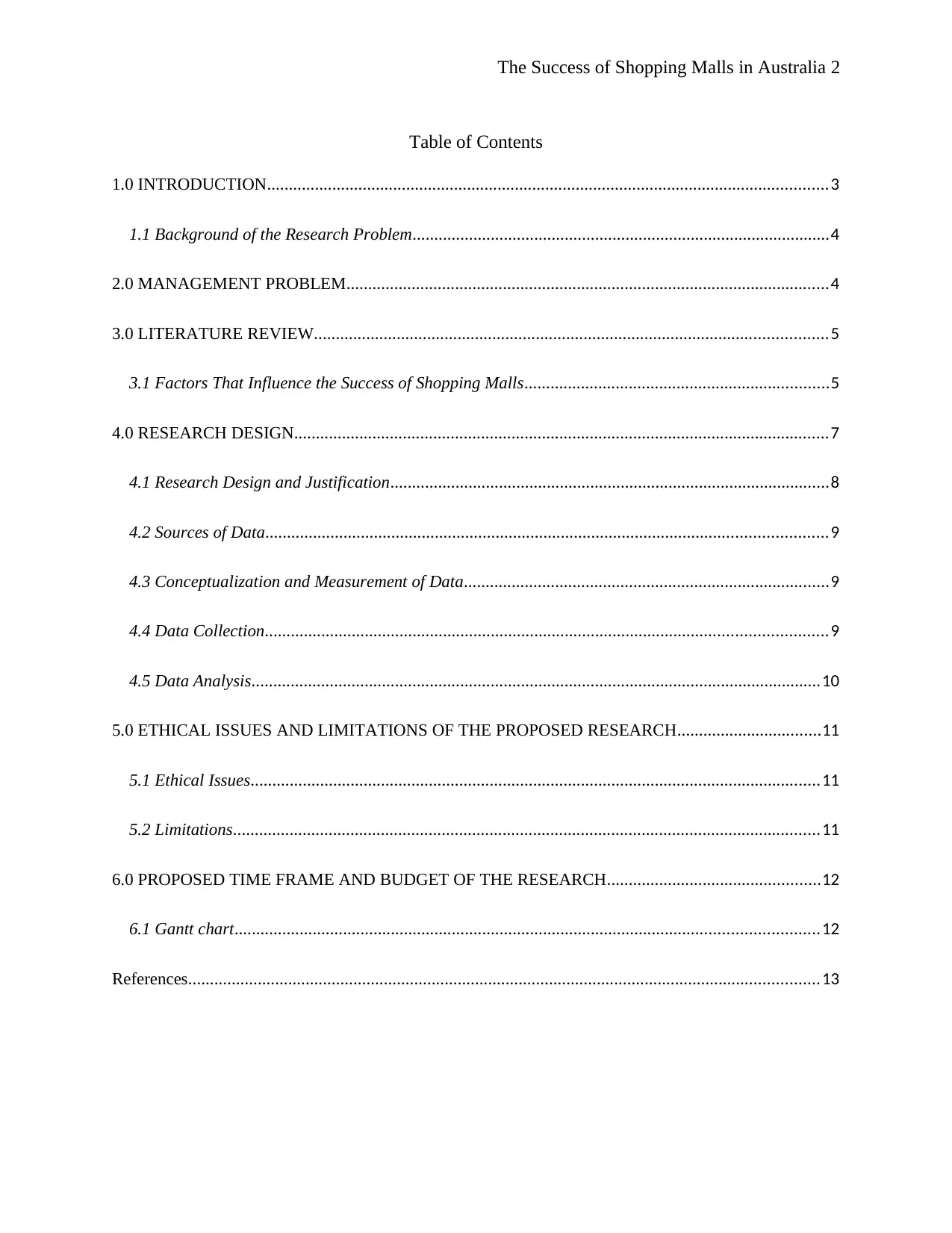
The Success of Shopping Malls in Australia 2
Table of Contents
1.0 INTRODUCTION.................................................................................................................................3
1.1 Background of the Research Problem................................................................................................4
2.0 MANAGEMENT PROBLEM...............................................................................................................4
3.0 LITERATURE REVIEW......................................................................................................................5
3.1 Factors That Influence the Success of Shopping Malls......................................................................5
4.0 RESEARCH DESIGN...........................................................................................................................7
4.1 Research Design and Justification.....................................................................................................8
4.2 Sources of Data.................................................................................................................................9
4.3 Conceptualization and Measurement of Data....................................................................................9
4.4 Data Collection.................................................................................................................................9
4.5 Data Analysis...................................................................................................................................10
5.0 ETHICAL ISSUES AND LIMITATIONS OF THE PROPOSED RESEARCH.................................11
5.1 Ethical Issues...................................................................................................................................11
5.2 Limitations.......................................................................................................................................11
6.0 PROPOSED TIME FRAME AND BUDGET OF THE RESEARCH.................................................12
6.1 Gantt chart......................................................................................................................................12
References.................................................................................................................................................13
Table of Contents
1.0 INTRODUCTION.................................................................................................................................3
1.1 Background of the Research Problem................................................................................................4
2.0 MANAGEMENT PROBLEM...............................................................................................................4
3.0 LITERATURE REVIEW......................................................................................................................5
3.1 Factors That Influence the Success of Shopping Malls......................................................................5
4.0 RESEARCH DESIGN...........................................................................................................................7
4.1 Research Design and Justification.....................................................................................................8
4.2 Sources of Data.................................................................................................................................9
4.3 Conceptualization and Measurement of Data....................................................................................9
4.4 Data Collection.................................................................................................................................9
4.5 Data Analysis...................................................................................................................................10
5.0 ETHICAL ISSUES AND LIMITATIONS OF THE PROPOSED RESEARCH.................................11
5.1 Ethical Issues...................................................................................................................................11
5.2 Limitations.......................................................................................................................................11
6.0 PROPOSED TIME FRAME AND BUDGET OF THE RESEARCH.................................................12
6.1 Gantt chart......................................................................................................................................12
References.................................................................................................................................................13
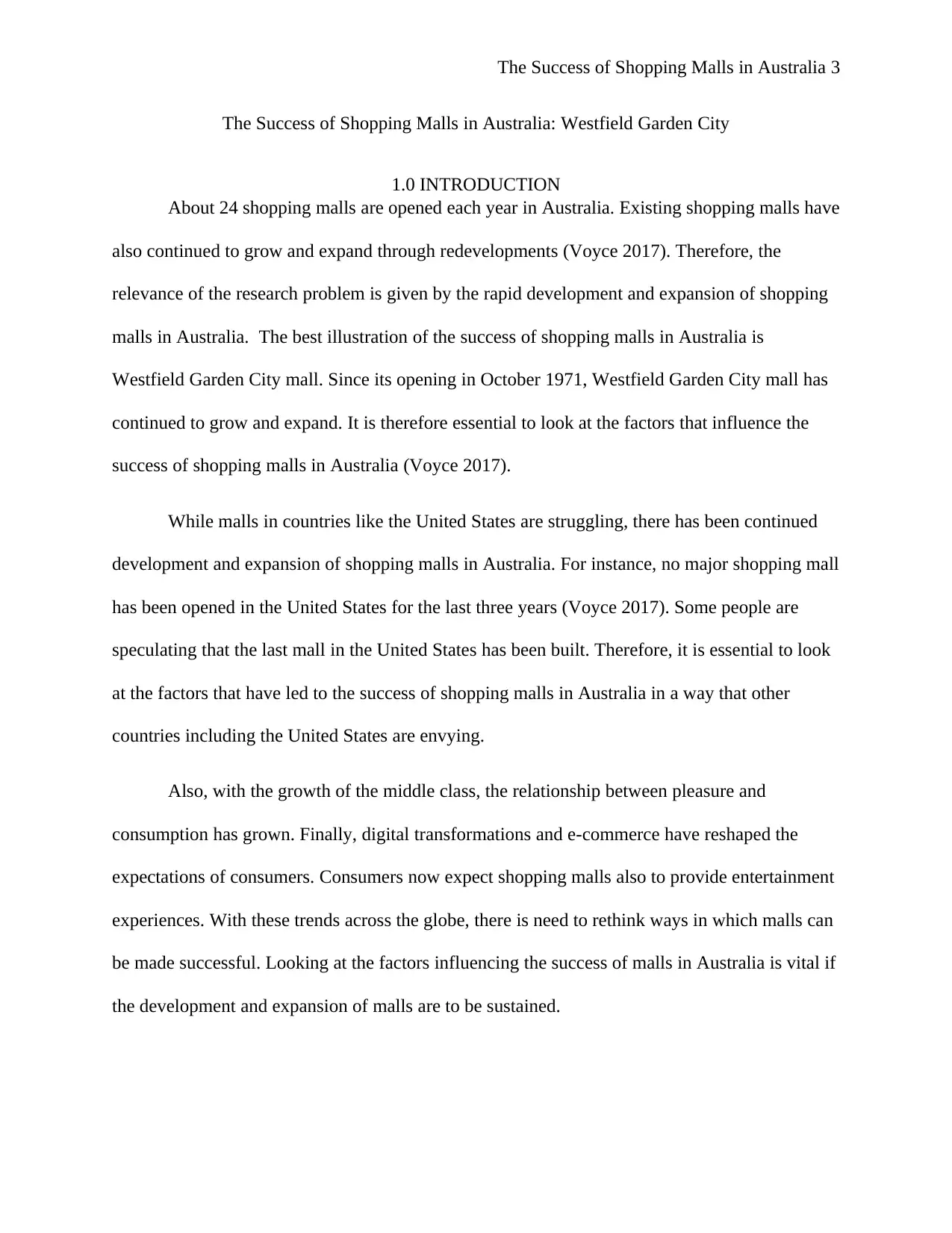
The Success of Shopping Malls in Australia 3
The Success of Shopping Malls in Australia: Westfield Garden City
1.0 INTRODUCTION
About 24 shopping malls are opened each year in Australia. Existing shopping malls have
also continued to grow and expand through redevelopments (Voyce 2017). Therefore, the
relevance of the research problem is given by the rapid development and expansion of shopping
malls in Australia. The best illustration of the success of shopping malls in Australia is
Westfield Garden City mall. Since its opening in October 1971, Westfield Garden City mall has
continued to grow and expand. It is therefore essential to look at the factors that influence the
success of shopping malls in Australia (Voyce 2017).
While malls in countries like the United States are struggling, there has been continued
development and expansion of shopping malls in Australia. For instance, no major shopping mall
has been opened in the United States for the last three years (Voyce 2017). Some people are
speculating that the last mall in the United States has been built. Therefore, it is essential to look
at the factors that have led to the success of shopping malls in Australia in a way that other
countries including the United States are envying.
Also, with the growth of the middle class, the relationship between pleasure and
consumption has grown. Finally, digital transformations and e-commerce have reshaped the
expectations of consumers. Consumers now expect shopping malls also to provide entertainment
experiences. With these trends across the globe, there is need to rethink ways in which malls can
be made successful. Looking at the factors influencing the success of malls in Australia is vital if
the development and expansion of malls are to be sustained.
The Success of Shopping Malls in Australia: Westfield Garden City
1.0 INTRODUCTION
About 24 shopping malls are opened each year in Australia. Existing shopping malls have
also continued to grow and expand through redevelopments (Voyce 2017). Therefore, the
relevance of the research problem is given by the rapid development and expansion of shopping
malls in Australia. The best illustration of the success of shopping malls in Australia is
Westfield Garden City mall. Since its opening in October 1971, Westfield Garden City mall has
continued to grow and expand. It is therefore essential to look at the factors that influence the
success of shopping malls in Australia (Voyce 2017).
While malls in countries like the United States are struggling, there has been continued
development and expansion of shopping malls in Australia. For instance, no major shopping mall
has been opened in the United States for the last three years (Voyce 2017). Some people are
speculating that the last mall in the United States has been built. Therefore, it is essential to look
at the factors that have led to the success of shopping malls in Australia in a way that other
countries including the United States are envying.
Also, with the growth of the middle class, the relationship between pleasure and
consumption has grown. Finally, digital transformations and e-commerce have reshaped the
expectations of consumers. Consumers now expect shopping malls also to provide entertainment
experiences. With these trends across the globe, there is need to rethink ways in which malls can
be made successful. Looking at the factors influencing the success of malls in Australia is vital if
the development and expansion of malls are to be sustained.
⊘ This is a preview!⊘
Do you want full access?
Subscribe today to unlock all pages.

Trusted by 1+ million students worldwide
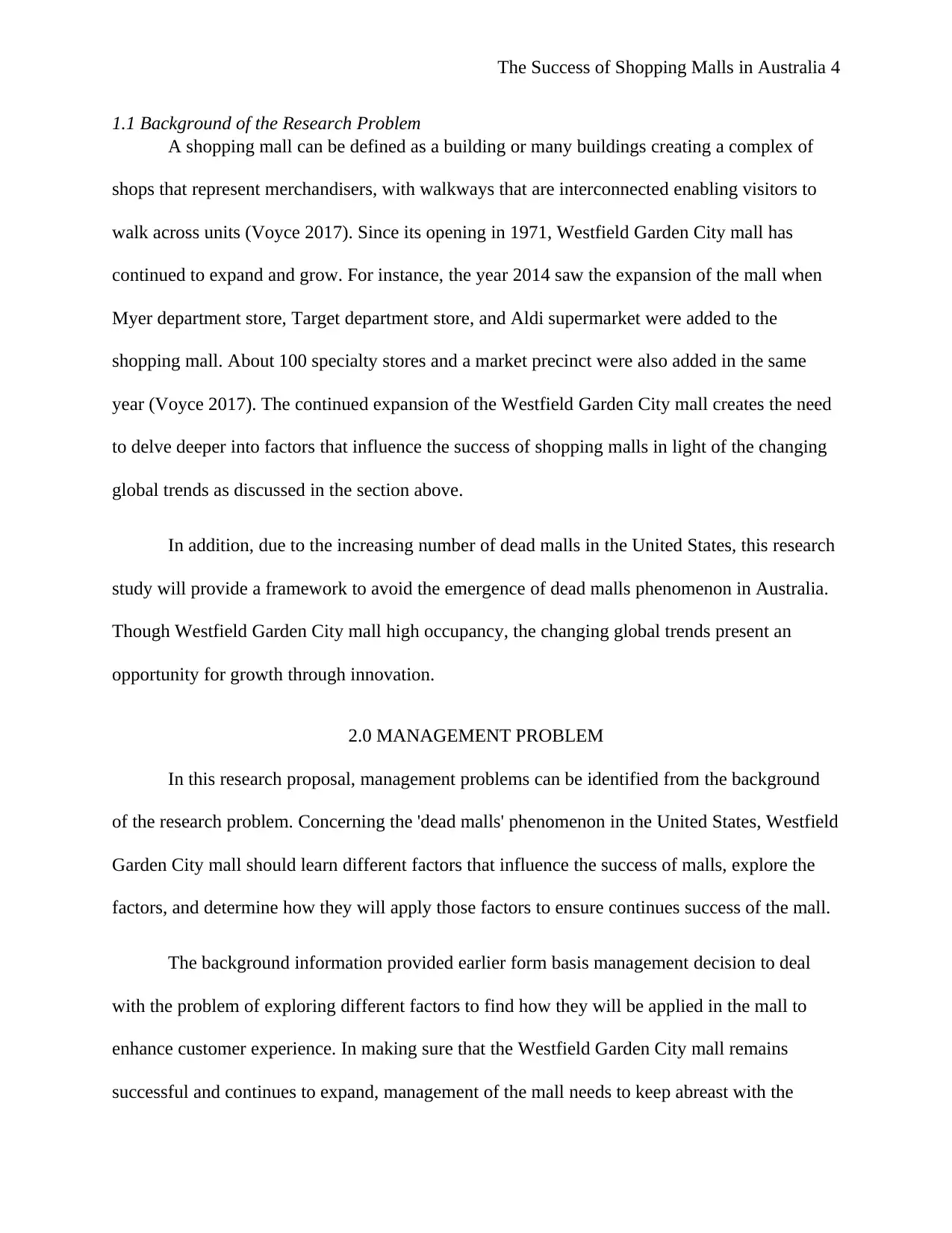
The Success of Shopping Malls in Australia 4
1.1 Background of the Research Problem
A shopping mall can be defined as a building or many buildings creating a complex of
shops that represent merchandisers, with walkways that are interconnected enabling visitors to
walk across units (Voyce 2017). Since its opening in 1971, Westfield Garden City mall has
continued to expand and grow. For instance, the year 2014 saw the expansion of the mall when
Myer department store, Target department store, and Aldi supermarket were added to the
shopping mall. About 100 specialty stores and a market precinct were also added in the same
year (Voyce 2017). The continued expansion of the Westfield Garden City mall creates the need
to delve deeper into factors that influence the success of shopping malls in light of the changing
global trends as discussed in the section above.
In addition, due to the increasing number of dead malls in the United States, this research
study will provide a framework to avoid the emergence of dead malls phenomenon in Australia.
Though Westfield Garden City mall high occupancy, the changing global trends present an
opportunity for growth through innovation.
2.0 MANAGEMENT PROBLEM
In this research proposal, management problems can be identified from the background
of the research problem. Concerning the 'dead malls' phenomenon in the United States, Westfield
Garden City mall should learn different factors that influence the success of malls, explore the
factors, and determine how they will apply those factors to ensure continues success of the mall.
The background information provided earlier form basis management decision to deal
with the problem of exploring different factors to find how they will be applied in the mall to
enhance customer experience. In making sure that the Westfield Garden City mall remains
successful and continues to expand, management of the mall needs to keep abreast with the
1.1 Background of the Research Problem
A shopping mall can be defined as a building or many buildings creating a complex of
shops that represent merchandisers, with walkways that are interconnected enabling visitors to
walk across units (Voyce 2017). Since its opening in 1971, Westfield Garden City mall has
continued to expand and grow. For instance, the year 2014 saw the expansion of the mall when
Myer department store, Target department store, and Aldi supermarket were added to the
shopping mall. About 100 specialty stores and a market precinct were also added in the same
year (Voyce 2017). The continued expansion of the Westfield Garden City mall creates the need
to delve deeper into factors that influence the success of shopping malls in light of the changing
global trends as discussed in the section above.
In addition, due to the increasing number of dead malls in the United States, this research
study will provide a framework to avoid the emergence of dead malls phenomenon in Australia.
Though Westfield Garden City mall high occupancy, the changing global trends present an
opportunity for growth through innovation.
2.0 MANAGEMENT PROBLEM
In this research proposal, management problems can be identified from the background
of the research problem. Concerning the 'dead malls' phenomenon in the United States, Westfield
Garden City mall should learn different factors that influence the success of malls, explore the
factors, and determine how they will apply those factors to ensure continues success of the mall.
The background information provided earlier form basis management decision to deal
with the problem of exploring different factors to find how they will be applied in the mall to
enhance customer experience. In making sure that the Westfield Garden City mall remains
successful and continues to expand, management of the mall needs to keep abreast with the
Paraphrase This Document
Need a fresh take? Get an instant paraphrase of this document with our AI Paraphraser
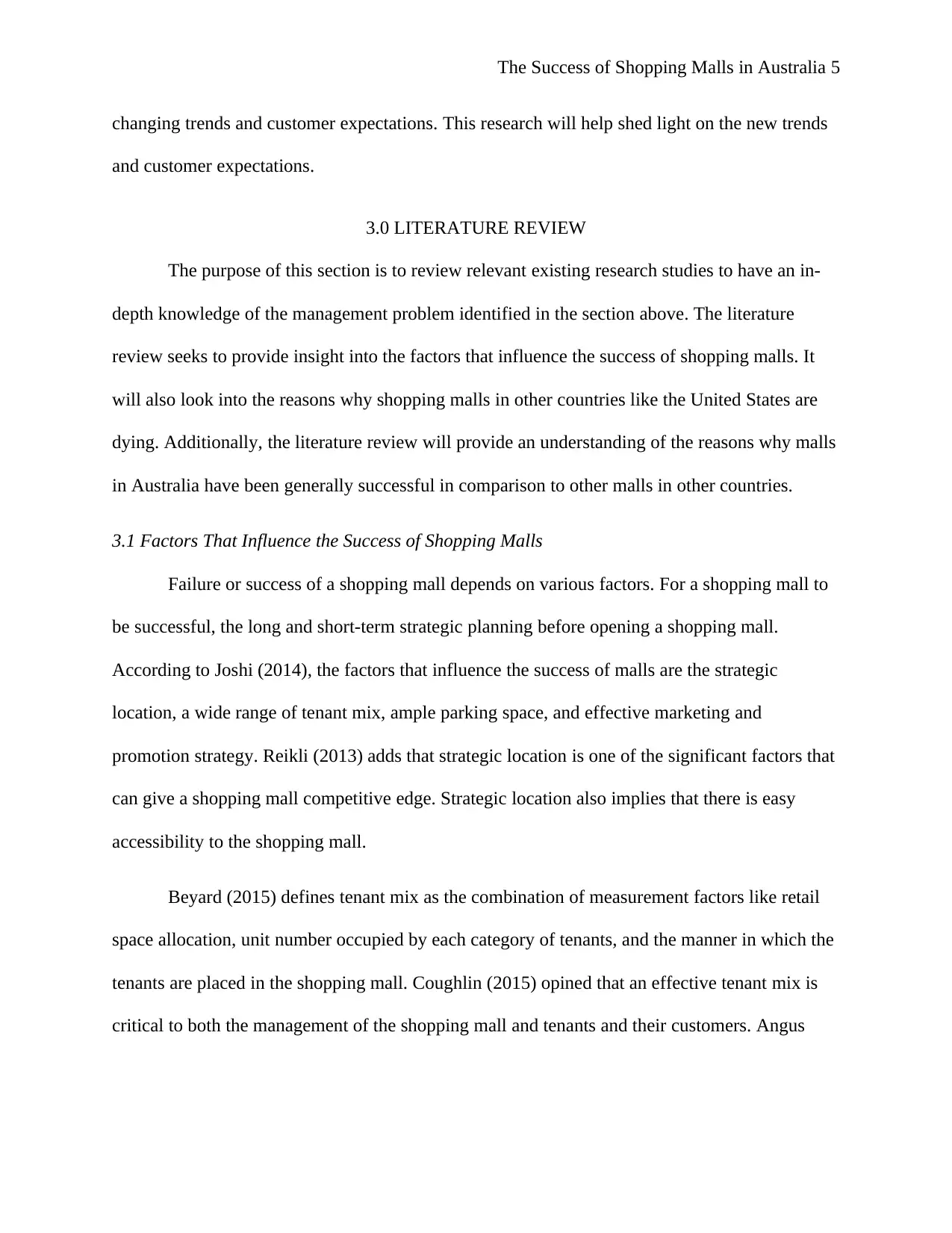
The Success of Shopping Malls in Australia 5
changing trends and customer expectations. This research will help shed light on the new trends
and customer expectations.
3.0 LITERATURE REVIEW
The purpose of this section is to review relevant existing research studies to have an in-
depth knowledge of the management problem identified in the section above. The literature
review seeks to provide insight into the factors that influence the success of shopping malls. It
will also look into the reasons why shopping malls in other countries like the United States are
dying. Additionally, the literature review will provide an understanding of the reasons why malls
in Australia have been generally successful in comparison to other malls in other countries.
3.1 Factors That Influence the Success of Shopping Malls
Failure or success of a shopping mall depends on various factors. For a shopping mall to
be successful, the long and short-term strategic planning before opening a shopping mall.
According to Joshi (2014), the factors that influence the success of malls are the strategic
location, a wide range of tenant mix, ample parking space, and effective marketing and
promotion strategy. Reikli (2013) adds that strategic location is one of the significant factors that
can give a shopping mall competitive edge. Strategic location also implies that there is easy
accessibility to the shopping mall.
Beyard (2015) defines tenant mix as the combination of measurement factors like retail
space allocation, unit number occupied by each category of tenants, and the manner in which the
tenants are placed in the shopping mall. Coughlin (2015) opined that an effective tenant mix is
critical to both the management of the shopping mall and tenants and their customers. Angus
changing trends and customer expectations. This research will help shed light on the new trends
and customer expectations.
3.0 LITERATURE REVIEW
The purpose of this section is to review relevant existing research studies to have an in-
depth knowledge of the management problem identified in the section above. The literature
review seeks to provide insight into the factors that influence the success of shopping malls. It
will also look into the reasons why shopping malls in other countries like the United States are
dying. Additionally, the literature review will provide an understanding of the reasons why malls
in Australia have been generally successful in comparison to other malls in other countries.
3.1 Factors That Influence the Success of Shopping Malls
Failure or success of a shopping mall depends on various factors. For a shopping mall to
be successful, the long and short-term strategic planning before opening a shopping mall.
According to Joshi (2014), the factors that influence the success of malls are the strategic
location, a wide range of tenant mix, ample parking space, and effective marketing and
promotion strategy. Reikli (2013) adds that strategic location is one of the significant factors that
can give a shopping mall competitive edge. Strategic location also implies that there is easy
accessibility to the shopping mall.
Beyard (2015) defines tenant mix as the combination of measurement factors like retail
space allocation, unit number occupied by each category of tenants, and the manner in which the
tenants are placed in the shopping mall. Coughlin (2015) opined that an effective tenant mix is
critical to both the management of the shopping mall and tenants and their customers. Angus
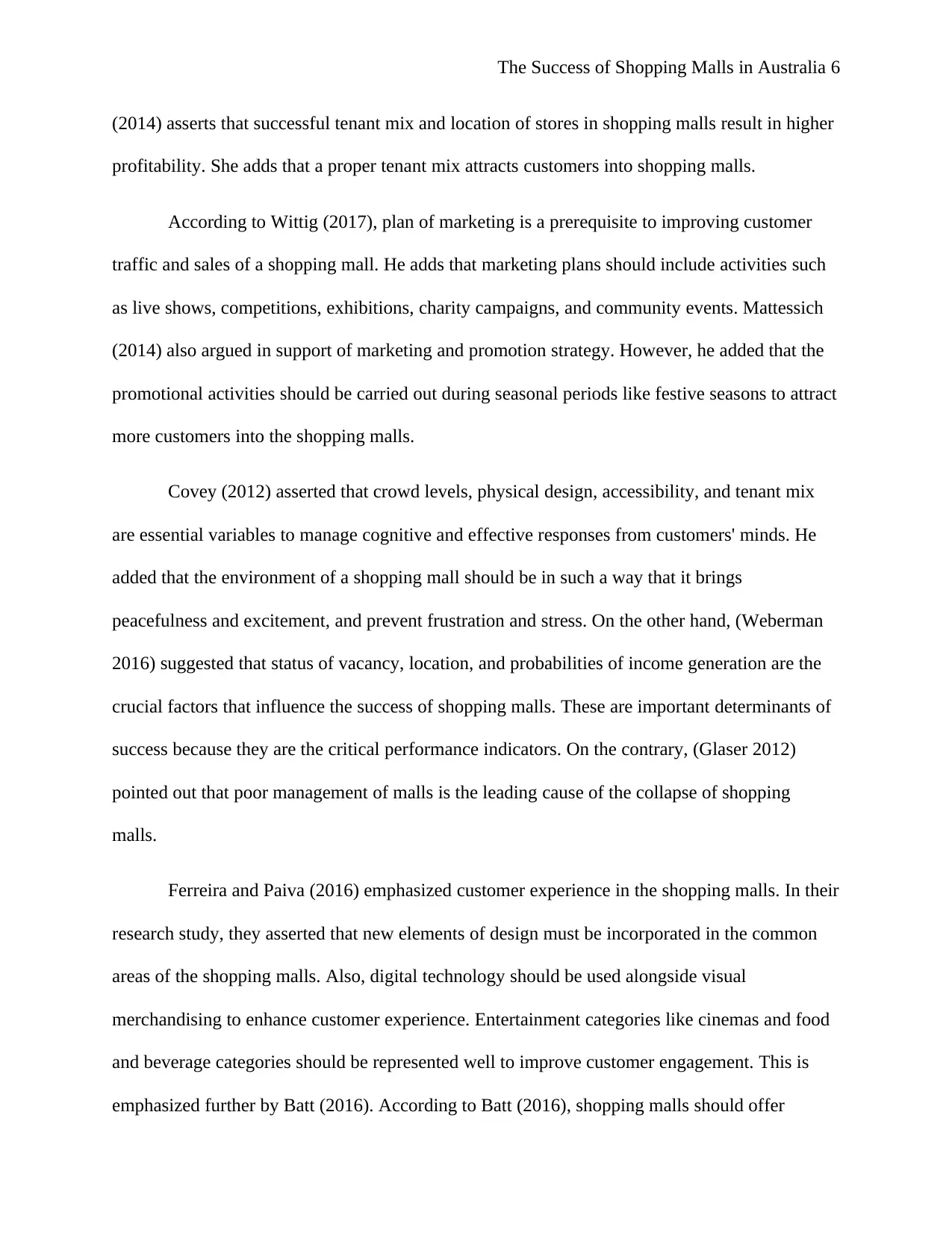
The Success of Shopping Malls in Australia 6
(2014) asserts that successful tenant mix and location of stores in shopping malls result in higher
profitability. She adds that a proper tenant mix attracts customers into shopping malls.
According to Wittig (2017), plan of marketing is a prerequisite to improving customer
traffic and sales of a shopping mall. He adds that marketing plans should include activities such
as live shows, competitions, exhibitions, charity campaigns, and community events. Mattessich
(2014) also argued in support of marketing and promotion strategy. However, he added that the
promotional activities should be carried out during seasonal periods like festive seasons to attract
more customers into the shopping malls.
Covey (2012) asserted that crowd levels, physical design, accessibility, and tenant mix
are essential variables to manage cognitive and effective responses from customers' minds. He
added that the environment of a shopping mall should be in such a way that it brings
peacefulness and excitement, and prevent frustration and stress. On the other hand, (Weberman
2016) suggested that status of vacancy, location, and probabilities of income generation are the
crucial factors that influence the success of shopping malls. These are important determinants of
success because they are the critical performance indicators. On the contrary, (Glaser 2012)
pointed out that poor management of malls is the leading cause of the collapse of shopping
malls.
Ferreira and Paiva (2016) emphasized customer experience in the shopping malls. In their
research study, they asserted that new elements of design must be incorporated in the common
areas of the shopping malls. Also, digital technology should be used alongside visual
merchandising to enhance customer experience. Entertainment categories like cinemas and food
and beverage categories should be represented well to improve customer engagement. This is
emphasized further by Batt (2016). According to Batt (2016), shopping malls should offer
(2014) asserts that successful tenant mix and location of stores in shopping malls result in higher
profitability. She adds that a proper tenant mix attracts customers into shopping malls.
According to Wittig (2017), plan of marketing is a prerequisite to improving customer
traffic and sales of a shopping mall. He adds that marketing plans should include activities such
as live shows, competitions, exhibitions, charity campaigns, and community events. Mattessich
(2014) also argued in support of marketing and promotion strategy. However, he added that the
promotional activities should be carried out during seasonal periods like festive seasons to attract
more customers into the shopping malls.
Covey (2012) asserted that crowd levels, physical design, accessibility, and tenant mix
are essential variables to manage cognitive and effective responses from customers' minds. He
added that the environment of a shopping mall should be in such a way that it brings
peacefulness and excitement, and prevent frustration and stress. On the other hand, (Weberman
2016) suggested that status of vacancy, location, and probabilities of income generation are the
crucial factors that influence the success of shopping malls. These are important determinants of
success because they are the critical performance indicators. On the contrary, (Glaser 2012)
pointed out that poor management of malls is the leading cause of the collapse of shopping
malls.
Ferreira and Paiva (2016) emphasized customer experience in the shopping malls. In their
research study, they asserted that new elements of design must be incorporated in the common
areas of the shopping malls. Also, digital technology should be used alongside visual
merchandising to enhance customer experience. Entertainment categories like cinemas and food
and beverage categories should be represented well to improve customer engagement. This is
emphasized further by Batt (2016). According to Batt (2016), shopping malls should offer
⊘ This is a preview!⊘
Do you want full access?
Subscribe today to unlock all pages.

Trusted by 1+ million students worldwide
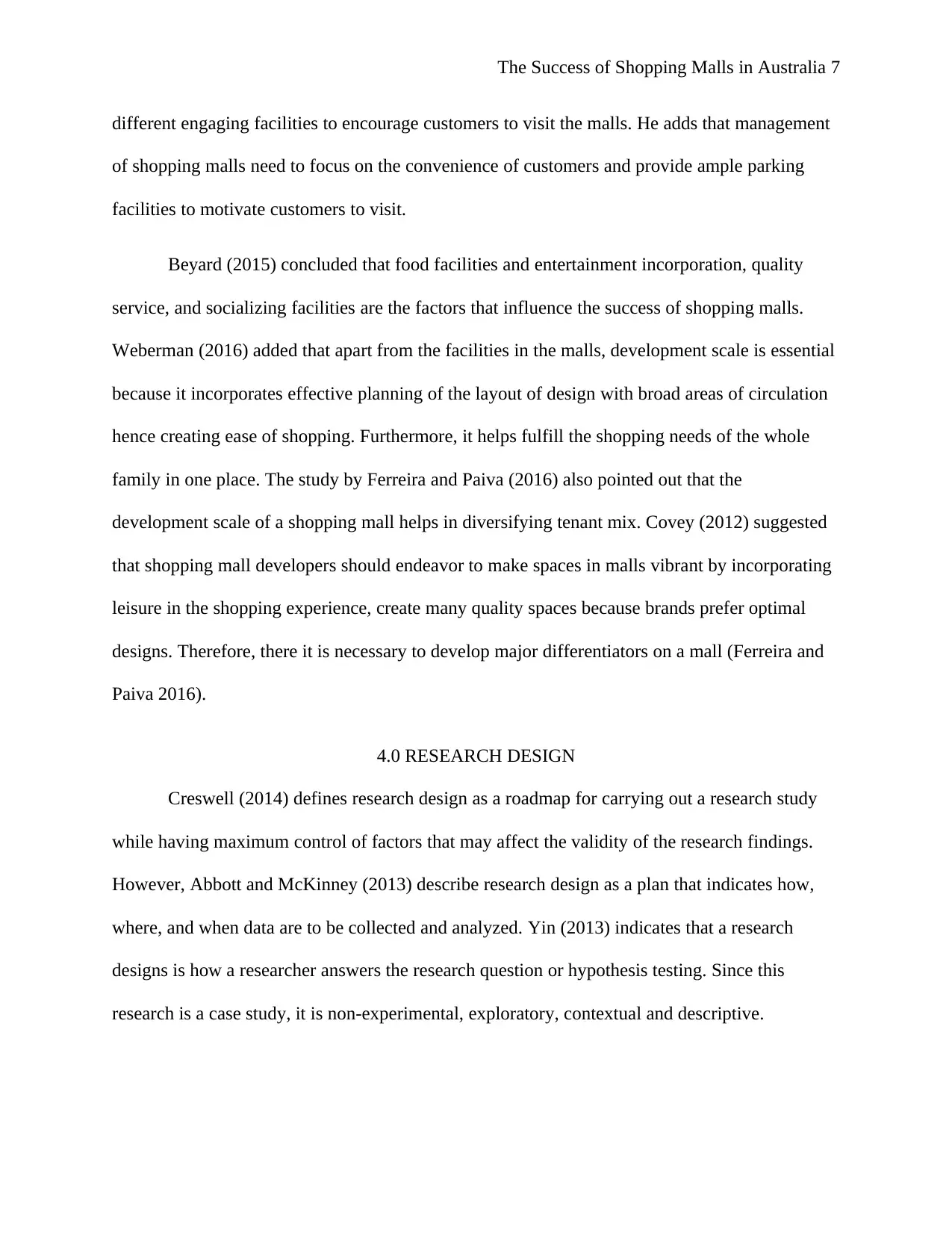
The Success of Shopping Malls in Australia 7
different engaging facilities to encourage customers to visit the malls. He adds that management
of shopping malls need to focus on the convenience of customers and provide ample parking
facilities to motivate customers to visit.
Beyard (2015) concluded that food facilities and entertainment incorporation, quality
service, and socializing facilities are the factors that influence the success of shopping malls.
Weberman (2016) added that apart from the facilities in the malls, development scale is essential
because it incorporates effective planning of the layout of design with broad areas of circulation
hence creating ease of shopping. Furthermore, it helps fulfill the shopping needs of the whole
family in one place. The study by Ferreira and Paiva (2016) also pointed out that the
development scale of a shopping mall helps in diversifying tenant mix. Covey (2012) suggested
that shopping mall developers should endeavor to make spaces in malls vibrant by incorporating
leisure in the shopping experience, create many quality spaces because brands prefer optimal
designs. Therefore, there it is necessary to develop major differentiators on a mall (Ferreira and
Paiva 2016).
4.0 RESEARCH DESIGN
Creswell (2014) defines research design as a roadmap for carrying out a research study
while having maximum control of factors that may affect the validity of the research findings.
However, Abbott and McKinney (2013) describe research design as a plan that indicates how,
where, and when data are to be collected and analyzed. Yin (2013) indicates that a research
designs is how a researcher answers the research question or hypothesis testing. Since this
research is a case study, it is non-experimental, exploratory, contextual and descriptive.
different engaging facilities to encourage customers to visit the malls. He adds that management
of shopping malls need to focus on the convenience of customers and provide ample parking
facilities to motivate customers to visit.
Beyard (2015) concluded that food facilities and entertainment incorporation, quality
service, and socializing facilities are the factors that influence the success of shopping malls.
Weberman (2016) added that apart from the facilities in the malls, development scale is essential
because it incorporates effective planning of the layout of design with broad areas of circulation
hence creating ease of shopping. Furthermore, it helps fulfill the shopping needs of the whole
family in one place. The study by Ferreira and Paiva (2016) also pointed out that the
development scale of a shopping mall helps in diversifying tenant mix. Covey (2012) suggested
that shopping mall developers should endeavor to make spaces in malls vibrant by incorporating
leisure in the shopping experience, create many quality spaces because brands prefer optimal
designs. Therefore, there it is necessary to develop major differentiators on a mall (Ferreira and
Paiva 2016).
4.0 RESEARCH DESIGN
Creswell (2014) defines research design as a roadmap for carrying out a research study
while having maximum control of factors that may affect the validity of the research findings.
However, Abbott and McKinney (2013) describe research design as a plan that indicates how,
where, and when data are to be collected and analyzed. Yin (2013) indicates that a research
designs is how a researcher answers the research question or hypothesis testing. Since this
research is a case study, it is non-experimental, exploratory, contextual and descriptive.
Paraphrase This Document
Need a fresh take? Get an instant paraphrase of this document with our AI Paraphraser
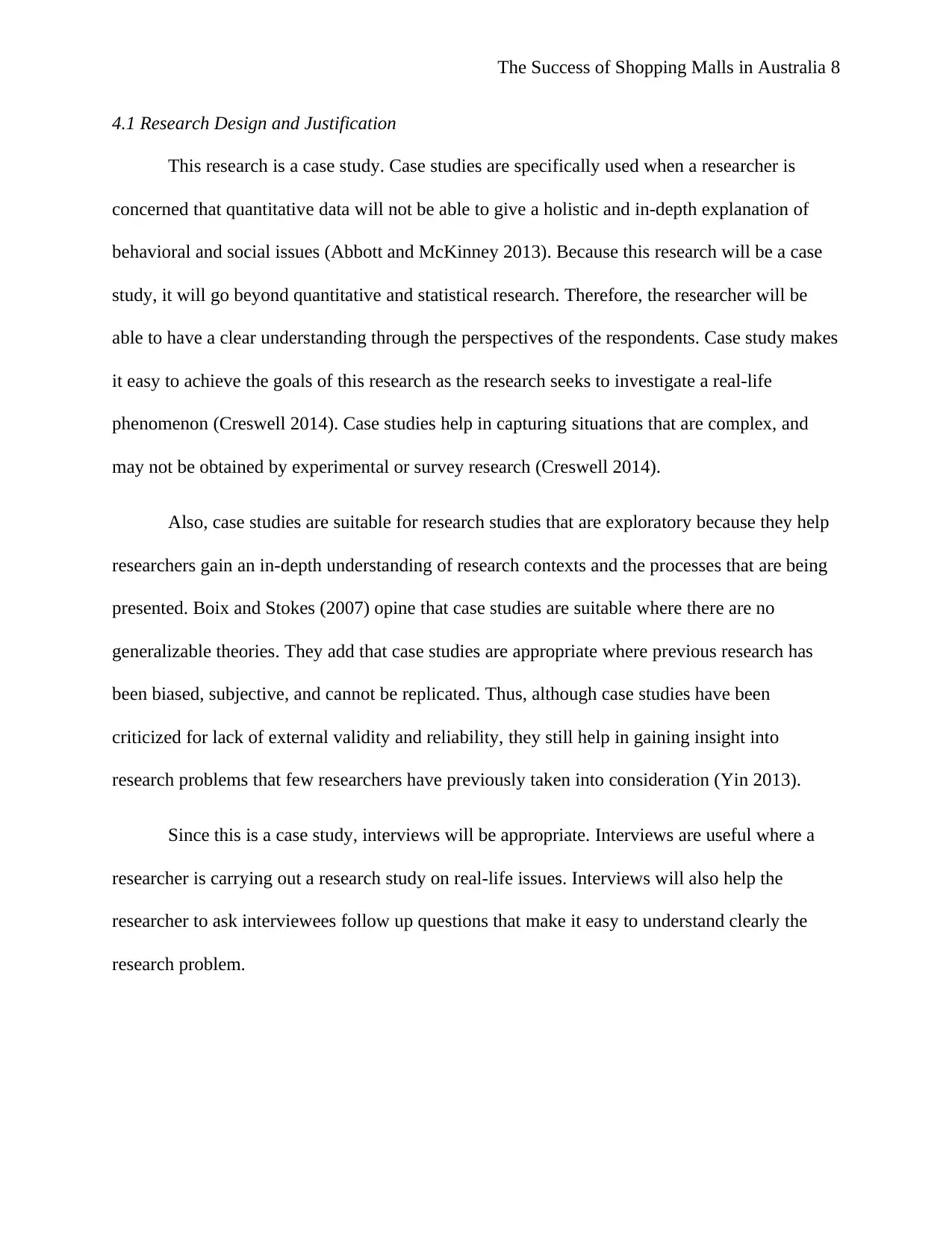
The Success of Shopping Malls in Australia 8
4.1 Research Design and Justification
This research is a case study. Case studies are specifically used when a researcher is
concerned that quantitative data will not be able to give a holistic and in-depth explanation of
behavioral and social issues (Abbott and McKinney 2013). Because this research will be a case
study, it will go beyond quantitative and statistical research. Therefore, the researcher will be
able to have a clear understanding through the perspectives of the respondents. Case study makes
it easy to achieve the goals of this research as the research seeks to investigate a real-life
phenomenon (Creswell 2014). Case studies help in capturing situations that are complex, and
may not be obtained by experimental or survey research (Creswell 2014).
Also, case studies are suitable for research studies that are exploratory because they help
researchers gain an in-depth understanding of research contexts and the processes that are being
presented. Boix and Stokes (2007) opine that case studies are suitable where there are no
generalizable theories. They add that case studies are appropriate where previous research has
been biased, subjective, and cannot be replicated. Thus, although case studies have been
criticized for lack of external validity and reliability, they still help in gaining insight into
research problems that few researchers have previously taken into consideration (Yin 2013).
Since this is a case study, interviews will be appropriate. Interviews are useful where a
researcher is carrying out a research study on real-life issues. Interviews will also help the
researcher to ask interviewees follow up questions that make it easy to understand clearly the
research problem.
4.1 Research Design and Justification
This research is a case study. Case studies are specifically used when a researcher is
concerned that quantitative data will not be able to give a holistic and in-depth explanation of
behavioral and social issues (Abbott and McKinney 2013). Because this research will be a case
study, it will go beyond quantitative and statistical research. Therefore, the researcher will be
able to have a clear understanding through the perspectives of the respondents. Case study makes
it easy to achieve the goals of this research as the research seeks to investigate a real-life
phenomenon (Creswell 2014). Case studies help in capturing situations that are complex, and
may not be obtained by experimental or survey research (Creswell 2014).
Also, case studies are suitable for research studies that are exploratory because they help
researchers gain an in-depth understanding of research contexts and the processes that are being
presented. Boix and Stokes (2007) opine that case studies are suitable where there are no
generalizable theories. They add that case studies are appropriate where previous research has
been biased, subjective, and cannot be replicated. Thus, although case studies have been
criticized for lack of external validity and reliability, they still help in gaining insight into
research problems that few researchers have previously taken into consideration (Yin 2013).
Since this is a case study, interviews will be appropriate. Interviews are useful where a
researcher is carrying out a research study on real-life issues. Interviews will also help the
researcher to ask interviewees follow up questions that make it easy to understand clearly the
research problem.
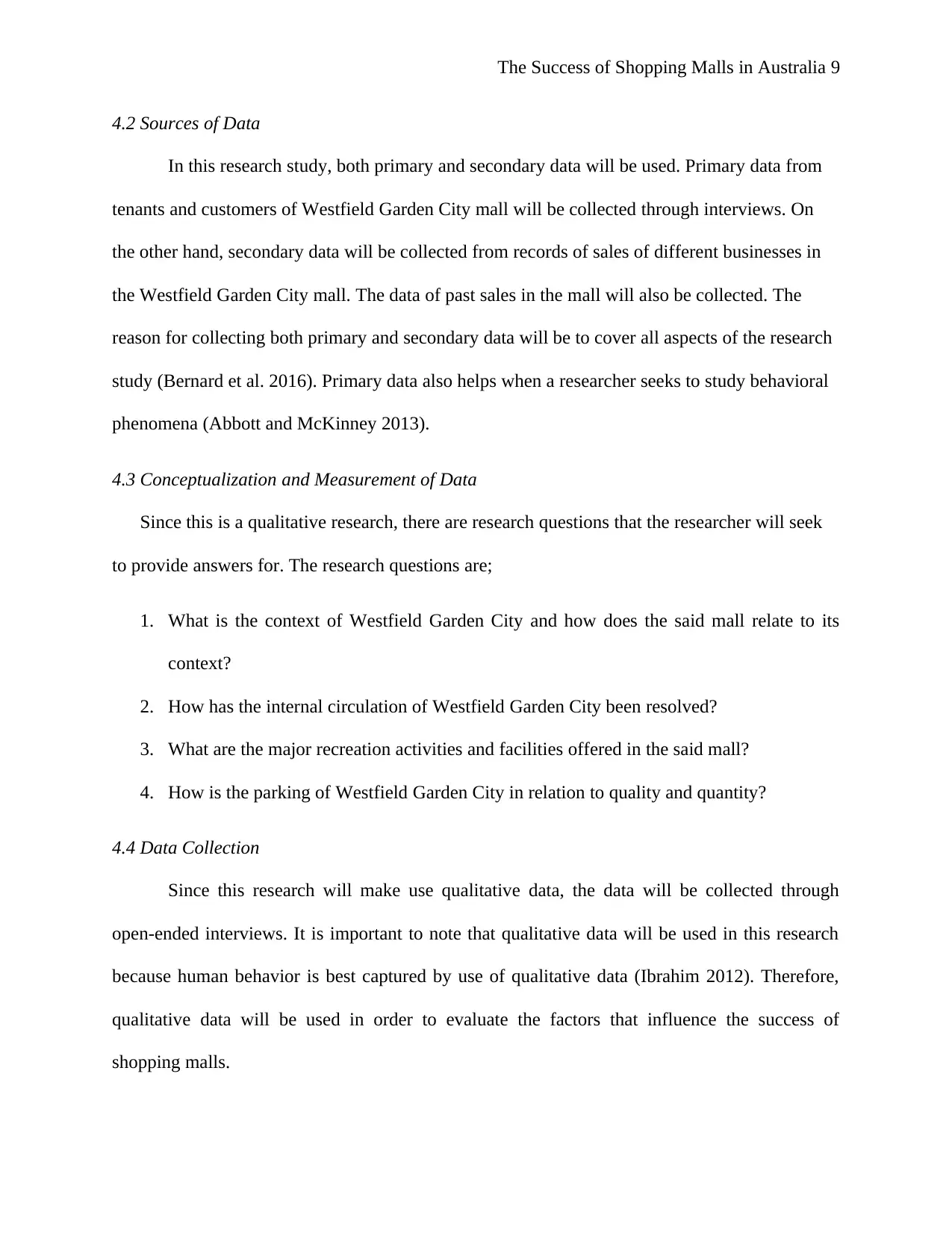
The Success of Shopping Malls in Australia 9
4.2 Sources of Data
In this research study, both primary and secondary data will be used. Primary data from
tenants and customers of Westfield Garden City mall will be collected through interviews. On
the other hand, secondary data will be collected from records of sales of different businesses in
the Westfield Garden City mall. The data of past sales in the mall will also be collected. The
reason for collecting both primary and secondary data will be to cover all aspects of the research
study (Bernard et al. 2016). Primary data also helps when a researcher seeks to study behavioral
phenomena (Abbott and McKinney 2013).
4.3 Conceptualization and Measurement of Data
Since this is a qualitative research, there are research questions that the researcher will seek
to provide answers for. The research questions are;
1. What is the context of Westfield Garden City and how does the said mall relate to its
context?
2. How has the internal circulation of Westfield Garden City been resolved?
3. What are the major recreation activities and facilities offered in the said mall?
4. How is the parking of Westfield Garden City in relation to quality and quantity?
4.4 Data Collection
Since this research will make use qualitative data, the data will be collected through
open-ended interviews. It is important to note that qualitative data will be used in this research
because human behavior is best captured by use of qualitative data (Ibrahim 2012). Therefore,
qualitative data will be used in order to evaluate the factors that influence the success of
shopping malls.
4.2 Sources of Data
In this research study, both primary and secondary data will be used. Primary data from
tenants and customers of Westfield Garden City mall will be collected through interviews. On
the other hand, secondary data will be collected from records of sales of different businesses in
the Westfield Garden City mall. The data of past sales in the mall will also be collected. The
reason for collecting both primary and secondary data will be to cover all aspects of the research
study (Bernard et al. 2016). Primary data also helps when a researcher seeks to study behavioral
phenomena (Abbott and McKinney 2013).
4.3 Conceptualization and Measurement of Data
Since this is a qualitative research, there are research questions that the researcher will seek
to provide answers for. The research questions are;
1. What is the context of Westfield Garden City and how does the said mall relate to its
context?
2. How has the internal circulation of Westfield Garden City been resolved?
3. What are the major recreation activities and facilities offered in the said mall?
4. How is the parking of Westfield Garden City in relation to quality and quantity?
4.4 Data Collection
Since this research will make use qualitative data, the data will be collected through
open-ended interviews. It is important to note that qualitative data will be used in this research
because human behavior is best captured by use of qualitative data (Ibrahim 2012). Therefore,
qualitative data will be used in order to evaluate the factors that influence the success of
shopping malls.
⊘ This is a preview!⊘
Do you want full access?
Subscribe today to unlock all pages.

Trusted by 1+ million students worldwide
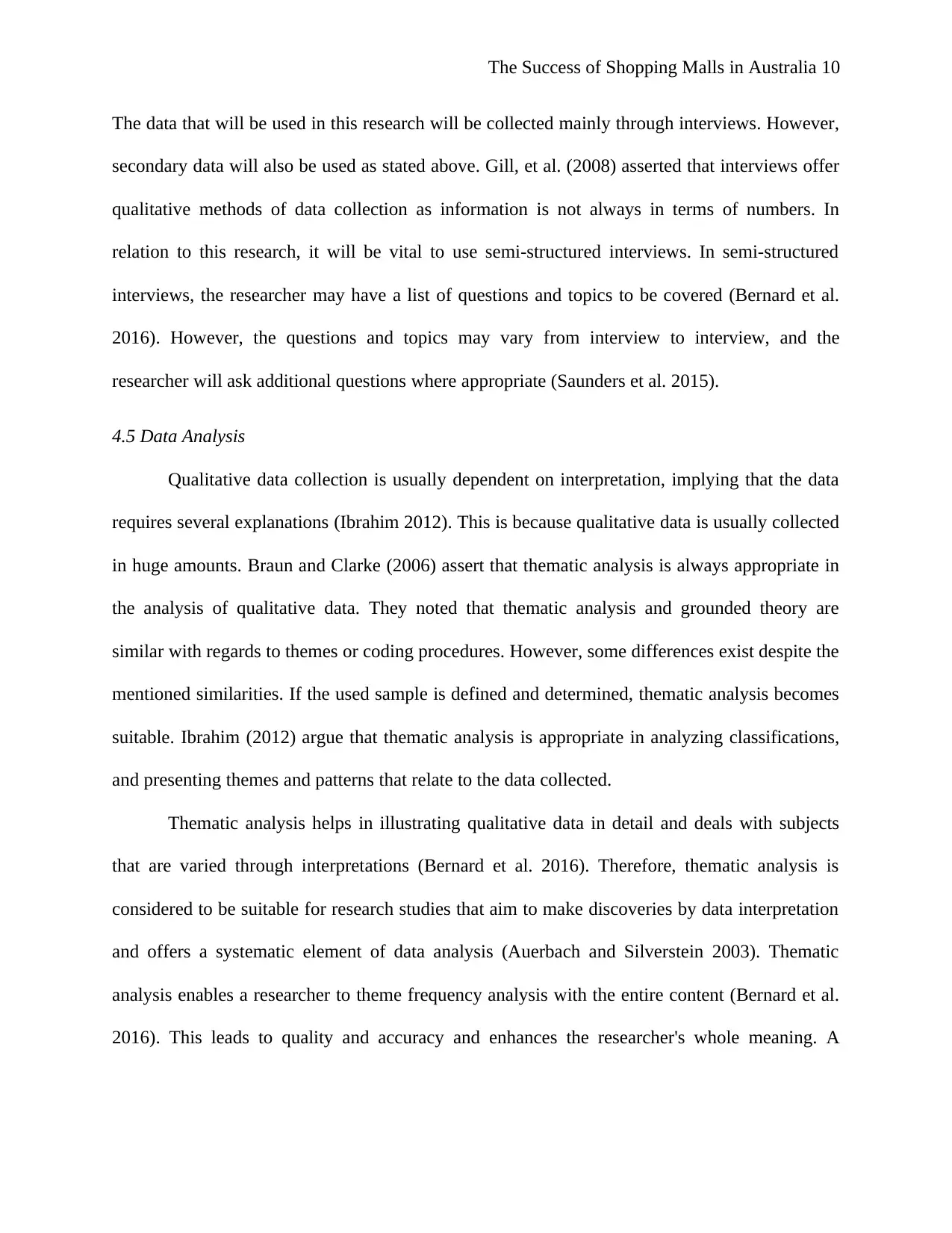
The Success of Shopping Malls in Australia 10
The data that will be used in this research will be collected mainly through interviews. However,
secondary data will also be used as stated above. Gill, et al. (2008) asserted that interviews offer
qualitative methods of data collection as information is not always in terms of numbers. In
relation to this research, it will be vital to use semi-structured interviews. In semi-structured
interviews, the researcher may have a list of questions and topics to be covered (Bernard et al.
2016). However, the questions and topics may vary from interview to interview, and the
researcher will ask additional questions where appropriate (Saunders et al. 2015).
4.5 Data Analysis
Qualitative data collection is usually dependent on interpretation, implying that the data
requires several explanations (Ibrahim 2012). This is because qualitative data is usually collected
in huge amounts. Braun and Clarke (2006) assert that thematic analysis is always appropriate in
the analysis of qualitative data. They noted that thematic analysis and grounded theory are
similar with regards to themes or coding procedures. However, some differences exist despite the
mentioned similarities. If the used sample is defined and determined, thematic analysis becomes
suitable. Ibrahim (2012) argue that thematic analysis is appropriate in analyzing classifications,
and presenting themes and patterns that relate to the data collected.
Thematic analysis helps in illustrating qualitative data in detail and deals with subjects
that are varied through interpretations (Bernard et al. 2016). Therefore, thematic analysis is
considered to be suitable for research studies that aim to make discoveries by data interpretation
and offers a systematic element of data analysis (Auerbach and Silverstein 2003). Thematic
analysis enables a researcher to theme frequency analysis with the entire content (Bernard et al.
2016). This leads to quality and accuracy and enhances the researcher's whole meaning. A
The data that will be used in this research will be collected mainly through interviews. However,
secondary data will also be used as stated above. Gill, et al. (2008) asserted that interviews offer
qualitative methods of data collection as information is not always in terms of numbers. In
relation to this research, it will be vital to use semi-structured interviews. In semi-structured
interviews, the researcher may have a list of questions and topics to be covered (Bernard et al.
2016). However, the questions and topics may vary from interview to interview, and the
researcher will ask additional questions where appropriate (Saunders et al. 2015).
4.5 Data Analysis
Qualitative data collection is usually dependent on interpretation, implying that the data
requires several explanations (Ibrahim 2012). This is because qualitative data is usually collected
in huge amounts. Braun and Clarke (2006) assert that thematic analysis is always appropriate in
the analysis of qualitative data. They noted that thematic analysis and grounded theory are
similar with regards to themes or coding procedures. However, some differences exist despite the
mentioned similarities. If the used sample is defined and determined, thematic analysis becomes
suitable. Ibrahim (2012) argue that thematic analysis is appropriate in analyzing classifications,
and presenting themes and patterns that relate to the data collected.
Thematic analysis helps in illustrating qualitative data in detail and deals with subjects
that are varied through interpretations (Bernard et al. 2016). Therefore, thematic analysis is
considered to be suitable for research studies that aim to make discoveries by data interpretation
and offers a systematic element of data analysis (Auerbach and Silverstein 2003). Thematic
analysis enables a researcher to theme frequency analysis with the entire content (Bernard et al.
2016). This leads to quality and accuracy and enhances the researcher's whole meaning. A
Paraphrase This Document
Need a fresh take? Get an instant paraphrase of this document with our AI Paraphraser
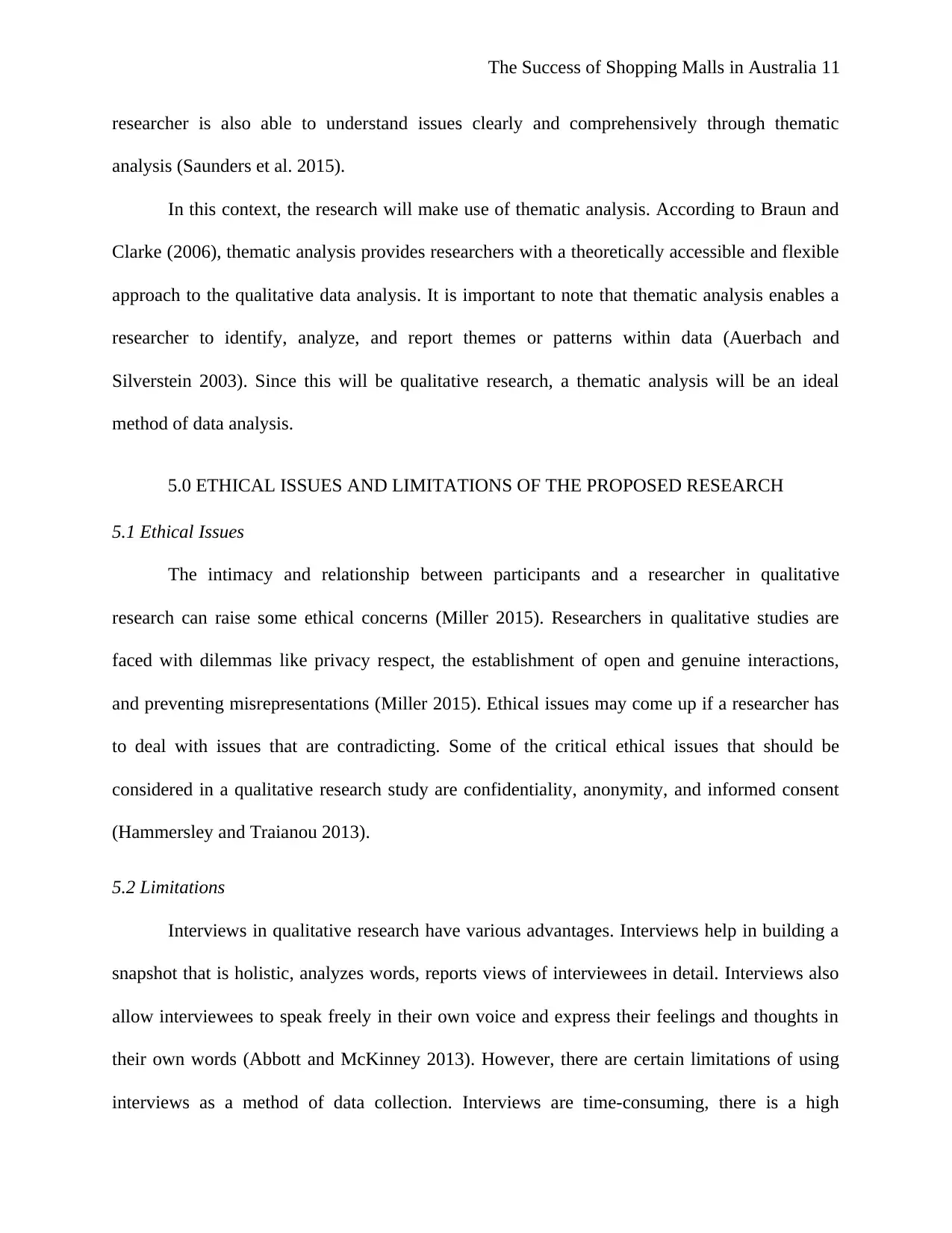
The Success of Shopping Malls in Australia 11
researcher is also able to understand issues clearly and comprehensively through thematic
analysis (Saunders et al. 2015).
In this context, the research will make use of thematic analysis. According to Braun and
Clarke (2006), thematic analysis provides researchers with a theoretically accessible and flexible
approach to the qualitative data analysis. It is important to note that thematic analysis enables a
researcher to identify, analyze, and report themes or patterns within data (Auerbach and
Silverstein 2003). Since this will be qualitative research, a thematic analysis will be an ideal
method of data analysis.
5.0 ETHICAL ISSUES AND LIMITATIONS OF THE PROPOSED RESEARCH
5.1 Ethical Issues
The intimacy and relationship between participants and a researcher in qualitative
research can raise some ethical concerns (Miller 2015). Researchers in qualitative studies are
faced with dilemmas like privacy respect, the establishment of open and genuine interactions,
and preventing misrepresentations (Miller 2015). Ethical issues may come up if a researcher has
to deal with issues that are contradicting. Some of the critical ethical issues that should be
considered in a qualitative research study are confidentiality, anonymity, and informed consent
(Hammersley and Traianou 2013).
5.2 Limitations
Interviews in qualitative research have various advantages. Interviews help in building a
snapshot that is holistic, analyzes words, reports views of interviewees in detail. Interviews also
allow interviewees to speak freely in their own voice and express their feelings and thoughts in
their own words (Abbott and McKinney 2013). However, there are certain limitations of using
interviews as a method of data collection. Interviews are time-consuming, there is a high
researcher is also able to understand issues clearly and comprehensively through thematic
analysis (Saunders et al. 2015).
In this context, the research will make use of thematic analysis. According to Braun and
Clarke (2006), thematic analysis provides researchers with a theoretically accessible and flexible
approach to the qualitative data analysis. It is important to note that thematic analysis enables a
researcher to identify, analyze, and report themes or patterns within data (Auerbach and
Silverstein 2003). Since this will be qualitative research, a thematic analysis will be an ideal
method of data analysis.
5.0 ETHICAL ISSUES AND LIMITATIONS OF THE PROPOSED RESEARCH
5.1 Ethical Issues
The intimacy and relationship between participants and a researcher in qualitative
research can raise some ethical concerns (Miller 2015). Researchers in qualitative studies are
faced with dilemmas like privacy respect, the establishment of open and genuine interactions,
and preventing misrepresentations (Miller 2015). Ethical issues may come up if a researcher has
to deal with issues that are contradicting. Some of the critical ethical issues that should be
considered in a qualitative research study are confidentiality, anonymity, and informed consent
(Hammersley and Traianou 2013).
5.2 Limitations
Interviews in qualitative research have various advantages. Interviews help in building a
snapshot that is holistic, analyzes words, reports views of interviewees in detail. Interviews also
allow interviewees to speak freely in their own voice and express their feelings and thoughts in
their own words (Abbott and McKinney 2013). However, there are certain limitations of using
interviews as a method of data collection. Interviews are time-consuming, there is a high
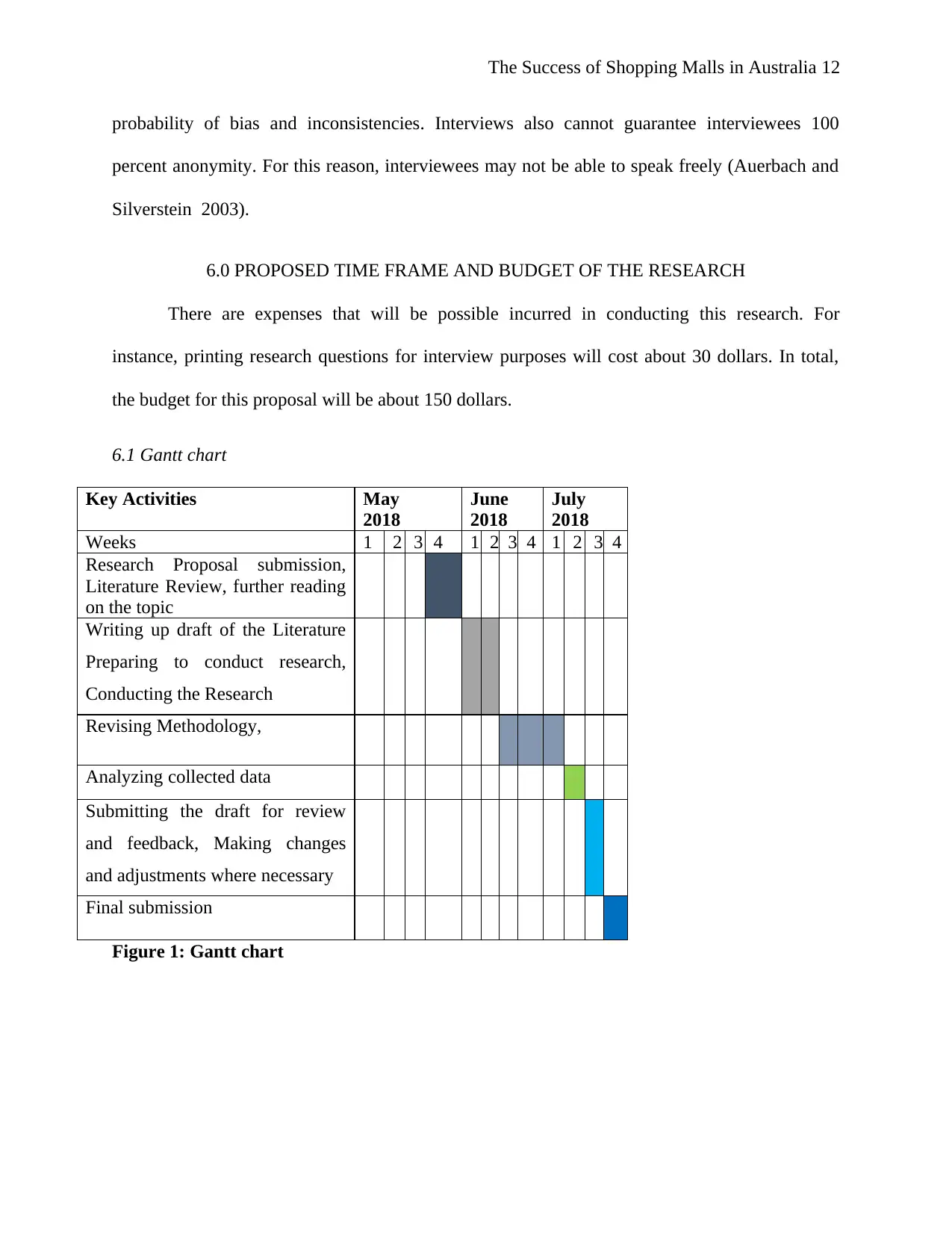
The Success of Shopping Malls in Australia 12
probability of bias and inconsistencies. Interviews also cannot guarantee interviewees 100
percent anonymity. For this reason, interviewees may not be able to speak freely (Auerbach and
Silverstein 2003).
6.0 PROPOSED TIME FRAME AND BUDGET OF THE RESEARCH
There are expenses that will be possible incurred in conducting this research. For
instance, printing research questions for interview purposes will cost about 30 dollars. In total,
the budget for this proposal will be about 150 dollars.
6.1 Gantt chart
Key Activities May
2018
June
2018
July
2018
Weeks 1 2 3 4 1 2 3 4 1 2 3 4
Research Proposal submission,
Literature Review, further reading
on the topic
Writing up draft of the Literature
Preparing to conduct research,
Conducting the Research
Revising Methodology,
Analyzing collected data
Submitting the draft for review
and feedback, Making changes
and adjustments where necessary
Final submission
Figure 1: Gantt chart
probability of bias and inconsistencies. Interviews also cannot guarantee interviewees 100
percent anonymity. For this reason, interviewees may not be able to speak freely (Auerbach and
Silverstein 2003).
6.0 PROPOSED TIME FRAME AND BUDGET OF THE RESEARCH
There are expenses that will be possible incurred in conducting this research. For
instance, printing research questions for interview purposes will cost about 30 dollars. In total,
the budget for this proposal will be about 150 dollars.
6.1 Gantt chart
Key Activities May
2018
June
2018
July
2018
Weeks 1 2 3 4 1 2 3 4 1 2 3 4
Research Proposal submission,
Literature Review, further reading
on the topic
Writing up draft of the Literature
Preparing to conduct research,
Conducting the Research
Revising Methodology,
Analyzing collected data
Submitting the draft for review
and feedback, Making changes
and adjustments where necessary
Final submission
Figure 1: Gantt chart
⊘ This is a preview!⊘
Do you want full access?
Subscribe today to unlock all pages.

Trusted by 1+ million students worldwide
1 out of 15
Related Documents
Your All-in-One AI-Powered Toolkit for Academic Success.
+13062052269
info@desklib.com
Available 24*7 on WhatsApp / Email
![[object Object]](/_next/static/media/star-bottom.7253800d.svg)
Unlock your academic potential
Copyright © 2020–2025 A2Z Services. All Rights Reserved. Developed and managed by ZUCOL.





